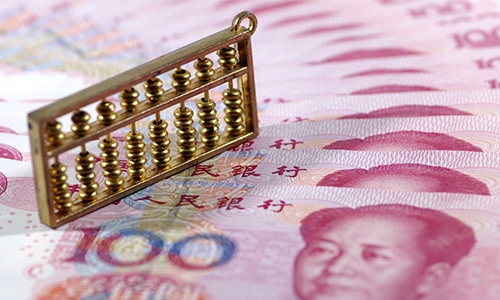
Renminbi Photo: VCG
A major Russian oil company has started to move away from the US dollar to the yuan in settlements in China, the latest move in the irreversible trend that China and Russia are accelerating their de-dollarization push to enhance the security and convenience of China-Russia trade against potential unilateral US sanctions, experts said on Sunday.
Bulk commodity goods will become the main business area in which local currencies - China's yuan and Russia's ruble - will be used in mutual trade settlement, thanks to the robust growth of China-Russia trade, experts noted.
Gazprom Neft, the oil arm of Russian gas giant Gazprom, will switch from US dollars to yuan and rubles to pay for refueling aircraft flying to or from China, the company's CEO Alexander Dyukov told reporters on the sidelines of the Eastern Economic Forum, Russia Today reported over the weekend.
The forum was held from Thursday to Saturday in Russia's far eastern city of Vladivostok.
"We started in September and may switch to having all settlements for jet fuel in yuan," Dyukov said, adding that Chinese airlines in Russian airports may soon buy fuel using the ruble.
An agreement was reached between Gazprom Neft, which has operations in 34 airports in China, and China's national jet fuel operator, after a lengthy period of talks, according to the report.
Song Kui, president of the Contemporary China-Russia Regional Economy Research Institute, told the Global Times on Sunday that this move will draw an active response from the Chinese side, and it's within expectation that the two big world powers are accelerating their pace in enhancing settlements in local currencies in mutual trade, moving away from the longstanding global financial system dominated by US dollar hegemony.
"Beijing and Moscow have a shared need in pushing ahead de-dollarization to enhance the security and convenience of bilateral trade amid any potential unilateral US sanctions," Song noted.
Moscow has been pushing for a greater role for its ruble in the global financial market, and Beijing is also promoting the internationalization of the yuan. Amid tensions between China and the US, some US politicians have threatened to extend the US' crackdown on China to the financial realm, warning that Beijing could be cut off from the US dollar payment system.
In April this year, the European Parliament approved a resolution that the EU should exclude Russia from the international payments network SWIFT over issues regarding Ukraine.
"Both China and Russia have felt the urge to hedge risks by the US monopoly over the global payments infrastructure, and it is an irreversible trend to promote non-dollar transactions," Li Xin, director of the Center for Russian and Central Asia Studies at the Shanghai Institutes for International Studies, told the Global Times on Sunday.
To expand the local currency stakes in bilateral trade, currency swaps between China and Russia should be increased, Li suggested.
The two countries signed a three-year currency swap deal worth 150 billion yuan ($24.5 billion) in 2014. The deal was extended for three years in 2017. The agreement allows each country's central bank to gain access to the other's currency without trading via the US dollar.
Russia has a strong demand for the yuan, and the two countries' local currency settlement cooperation mechanisms and channels have continuously improved, and legal protection has also gradually strengthened. The yuan accounts for an increasing proportion of local currency settlements in China and Russia, and the scope of its use continues to expand, according to a report by Russian, East European & Central Asian Studies Institute.
Statistics from the Central Bank of Russia and the nation's customs authority showed that the yuan accounts for more than 17 percent of China-Russia bilateral trade settlements and more than 12 percent of Russia's international reserves.
In the first half of 2020, bilateral trade settlements between China and Russia in the US dollar fell to 46 percent from 90 percent in 2015, while deals settled in the yuan and ruble jumped to 24 percent, a report by Renmin University of China showed last year.
Song said that bulk commodities like oil, natural gas and coal will be the main areas that will see more use of local currency settlements in the near future, thanks to the robust growth of bilateral trade, despite headwinds of the COVID-19 pandemic.
In 2020, bilateral trade between China and Russia reached $107.77 billion, exceeding the $100 billion mark for three consecutive years. China remained Russia's largest trading partner.
China's major exports to Russia included mobile phones, laptops, and auto parts while Russian crude oil, natural gas, coal, vegetable oil and other products came to China.




